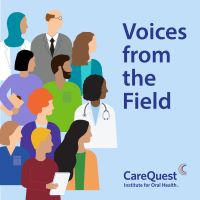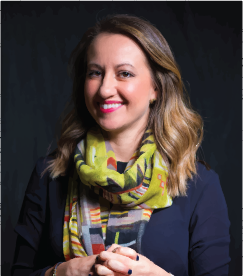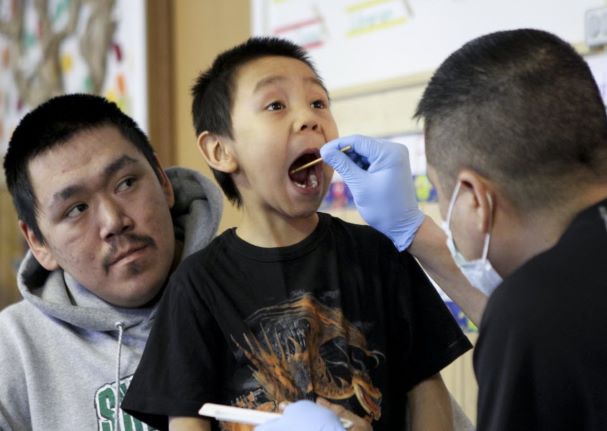 Indigenous communities face several barriers to accessing oral health care. For American Indian and Alaska Native (AI/AN) families who live on tribal lands, often in rural areas, a shortage of dental providers is a common hurdle. This is among many challenges and varied solutions highlighted in a new white paper, “American Indian and Alaska Native Communities Face a ‘Disproportionate Burden of Oral Disease’: Reversing Inequities Involves Challenges and Opportunities.”
Indigenous communities face several barriers to accessing oral health care. For American Indian and Alaska Native (AI/AN) families who live on tribal lands, often in rural areas, a shortage of dental providers is a common hurdle. This is among many challenges and varied solutions highlighted in a new white paper, “American Indian and Alaska Native Communities Face a ‘Disproportionate Burden of Oral Disease’: Reversing Inequities Involves Challenges and Opportunities.”
Julie Seward, RDH, MEd, a co-author on the paper, and the oral health programs manager for the Southern Plains Tribal Health Board (SPTHB), knows what it’s like to live in a dental desert.
She grew up in a small, rural town in Oklahoma, with a pediatric dentist more than 60 miles away. With her parents working full time, Seward’s grandmother would make the one-hour drive to ensure she and her siblings got dental care.
“While it was inconvenient to make a two-hour round trip and miss school, I cherished the time with my grandmother,” she says. “Those trips to the dentist were surrounded by positive reinforcements and joyful experiences that fueled my passion to work in oral health.”

Julie Seward, RDH, MEd
Despite the inequity, Seward, a member of the Cherokee Nation, sees silver linings from the experience, including the inspiration to pursue an oral health career.
“I particularly connected with the hygienists in the office,” she says, “which is why I chose to be a dental hygienist.”
After practicing and teaching dental hygiene, in 2016, Seward joined SPTHB, an organization that improves public health among the 43 federally recognized tribes in Kansas, Oklahoma, and Texas. It is also a liaison to the National Indian Health Board. She brought the experience and knowledge to the research and writing process, and here offers several insights on disparities and potential solutions highlighted in the new paper.
This paper describes how dental disease falls hardest on indigenous communities, while also looking at diverse solutions. Who do you think will benefit from reading it?
It’s for advocacy organizations, as another tool for their tool belt. It’s for the lay person, to understand and support efforts toward oral health equity. And for those working at the state, national, or federal level, it’s further evidence that we must invest in native communities in a sustainable way.
But most importantly, it’s for Indian country, to let them know we are all working hard for change.
Change is certainly needed, as AI/AN communities have been historically neglected when it comes to oral health access and care. Can you explain why?
This is a multifaceted question. But I will attempt to come at it from a data integrity angle:
When AI/AN populations are consistently “othered” in the data, how does that serve us? How does that provide evidence and awareness of the struggles we face, so that we have the level of resources and support needed? How does that tell our stories? It doesn’t. By not collecting and reporting AI/AN data, and racially misclassifying AI/AN data that is collected, it portrays that we do not exist.
We must address significant flaws in the system so we are accurately represented in the data. We must establish standardization in collecting and reporting AI/AN data nationwide, alongside and in consultation with tribes, and I believe there are efforts underway to address this.

Alaska Native boy gets mouth swabbed
What are one or two of the steepest barriers to good oral health that AI/AN communities currently face?
To start, racial stereotypes and implicit bias can be a significant barrier.
The historical context — and layers of systemic and structural racism — has molded a very complicated health care delivery system for AI/ANs. Those not familiar with this landscape and its historical implications may assume AI/AN people have “universal” or “free” health care [through the ITU, which is part of the Indian Health Service (IHS), an agency in the US Department of Health and Human Services, Tribal and Urban Indian Healthcare delivery systems] [I think this puts our communities in a silo.
Secondly, we do not have anywhere near the amount of AI/AN representation in the oral health workforce. The IHS is chronically underfunded, which presents many issues with their ability to provide quality, consistent care.
Additionally, the Westernization and colonization of health care delivery generally omit key traditional and cultural practices that are so important in treating the whole person. Oral health is health, and we need to continue to work from that frame of mind. There have been flagrant attacks on tribal sovereignty that impede tribes’ ability to use culturally centric, evidenced-based approaches to improve oral heath in their communities.
Can you share more insight into what is driving some of these barriers and challenges?
Abigail Echo Hawk, citizen of the Pawnee Nation of Oklahoma, executive vice president of the Seattle Indian Health Board, and director of the Urban Indian Health Institute, recently presented “Data Practice through the Lens of American Indian/Alaska Native Communities” on a CDC [Centers for Disease Control and Prevention] webinar.
During this presentation, she mentions that communities of color are not “problems to solve,” but that these communities are the answers. She says:
“Data looks at people of color as problems to solve. And we are not. We are, in fact, every single one of the answers. When consulted; when and how we are able to use our decolonized data practices; when tribal sovereignty is respected; when tribal epidemiology centers and tribal public health authorities are respected; and we receive the resources we have a legal right to, through our treaties, we are not the problem to solve. The systems are the problems to solve.”
That is such a powerful statement.
Are there one or two opportunities that surfaced when researching this report that make you hopeful about improving AI/AN communities’ oral health?
Far too often, the AI/AN data that are reported show the deficits and the disparities. But what I would love to see more often are the ways tribes are innovative in addressing the health and well-being of their communities. I think that innovation is apparent when you look at the data [about] medical-dental integration. Tribes have been focused on person-centered care since time immemorial.
Do you have a story that illustrates the promise of a solution that you’re excited about?
One of the first trips that I took [for SPTHB] was to a conference in Washington, DC, where I attended a session focused on dental therapy advocacy for tribes. [Dental therapists are oral health professionals brought to the US by Alaska Native communities. Complementing the dental team, and often from the communities they serve, they expand access to routine care in underserved areas.]
I sat beside the executive director of a national tribal organization. She asked me about my particular interest in tribal public health and oral health. I let her know that I was a tribal citizen and described how I ended up in this role. She said wholeheartedly, “Thank you so much for coming back. Thank you for doing this work.” There was true gratitude in her face.
I see so many young native people who are passionate about helping their communities and addressing health equity. Native youth are reconnecting with their culture and traditions and rethinking the way we approach issues. I am so excited to see this next generation come into the workforce and shake things up a bit.
